 W
WBrewing is the production of beer by steeping a starch source in water and fermenting the resulting sweet liquid with yeast. It may be done in a brewery by a commercial brewer, at home by a homebrewer, or by a variety of traditional methods such as communally by the indigenous peoples in Brazil when making cauim. Brewing has taken place since around the 6th millennium BC, and archaeological evidence suggests that emerging civilizations, including ancient Egypt and Mesopotamia, brewed beer. Since the nineteenth century the brewing industry has been part of most western economies.
 W
WAlewife, also brewess or brewster, is a historical term for a woman who brewed ale for commercial sale. Women have been active in brewing since before the process's industrialisation.
 W
WAlpha acids are a class of chemical compounds primarily of importance to the production of beer. They are found in the resin glands of the flowers of the hop plant and are the source of hop bitterness. Alpha acids may be isomerized to form iso-alpha acids by the application of heat in solution. Iso-alpha acids (iso-α-acids) are typically produced in beer from the addition of hops to the boiling wort. The degree of isomerization and the amount of bitter flavor produced by the addition of hops is highly dependent on the length of time the hops are boiled. Longer boil times will result in isomerization of more alpha acids and thus increased bitterness.
 W
WA barrel is one of several units of volume applied in various contexts; there are dry barrels, fluid barrels, oil barrels, and so forth. For historical reasons the volumes of some barrel units are roughly double the volumes of others; volumes in common use range approximately from 100 to 200 litres. In many connections the term drum is used almost interchangeably with barrel.
 W
WA barrel-aged beer is a beer that has been aged for a period of time in a wooden barrel. Typically, these barrels once housed bourbon, whisky, wine, or, to a lesser extent, brandy, sherry, or port. There is a particular tradition of barrel ageing beer in Belgium, notably of lambic beers. The first bourbon barrel-aged beers were produced in the United States in the early 1990s.
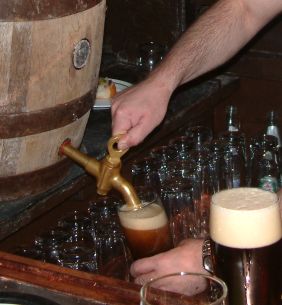 W
WBeer is one of the oldest and most widely consumed alcoholic drinks in the world, and the third most popular drink overall after water and tea. Beer is brewed from cereal grains—most commonly from malted barley, though wheat, maize (corn), and rice are also used. During the brewing process, fermentation of the starch sugars in the wort produces ethanol and carbonation in the resulting beer. Most modern beer is brewed with hops, which add bitterness and other flavours and act as a natural preservative and stabilizing agent. Other flavouring agents such as gruit, herbs, or fruits may be included or used instead of hops. In commercial brewing, the natural carbonation effect is often removed during processing and replaced with forced carbonation.
 W
WAlthough most beer is brewed using cereal grains—most commonly malted barley—as a source of starch sugars, it can also be made from bread.
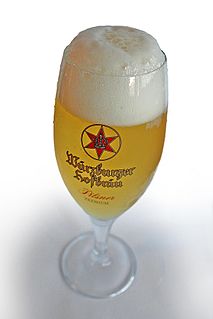 W
WBeer head, is the frothy foam on top of beer which is produced by bubbles of gas, predominantly carbon dioxide, rising to the surface. The elements that produce the head are wort protein, yeast and hop residue. The carbon dioxide that forms the bubbles in the head is produced during fermentation. The carbonation can occur before or after bottling the beer. If the beer continues fermenting in the bottle, then it naturally carbonates and the head is formed upon opening and/or pouring the beer. If the beer is pasteurized or filtered then the beer must be force carbonated using pressurized gas.
 W
WBrewing is the production of beer by steeping a starch source in water and fermenting the resulting sweet liquid with yeast. It may be done in a brewery by a commercial brewer, at home by a homebrewer, or by a variety of traditional methods such as communally by the indigenous peoples in Brazil when making cauim. Brewing has taken place since around the 6th millennium BC, and archaeological evidence suggests that emerging civilizations, including ancient Egypt and Mesopotamia, brewed beer. Since the nineteenth century the brewing industry has been part of most western economies.
 W
WBrewing is the production of beer by steeping a starch source in water and fermenting the resulting sweet liquid with yeast. It may be done in a brewery by a commercial brewer, at home by a homebrewer, or by a variety of traditional methods such as communally by the indigenous peoples in Brazil when making cauim. Brewing has taken place since around the 6th millennium BC, and archaeological evidence suggests that emerging civilizations, including ancient Egypt and Mesopotamia, brewed beer. Since the nineteenth century the brewing industry has been part of most western economies.
 W
WBottling lines are production lines that fill a product, generally a beverage, into bottles on a large scale. Many prepared foods are also bottled, such as sauces, syrups, marinades, oils and vinegars.
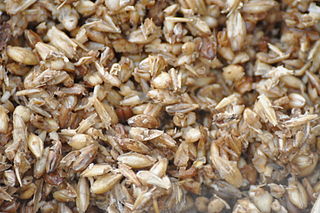 W
WBrewer's spent grain (BSG) or draff is a food waste that is a byproduct of the brewing industry that makes up 85 percent of brewing waste. BSG is obtained as a mostly solid residue after wort production in the brewing process. The product is initially wet, with a short shelf-life, but can be dried and processed in various ways to preserve it.
 W
WA brewhouse is a building made for brewing beer and ale. This could be a part of a specialized brewery operation, but historically a brewhouse is a private building only meant for domestic production.
 W
WBeerXML is a free, fully defined XML data description standard designed for the exchange of beer brewing recipes and other brewing data. Tables of recipes as well as other records such as hop schedules and malt bills can be represented using BeerXML for use by brewing software.
 W
WBright beer is beer in which yeast is no longer in suspension. There are several methods used for clearing yeast from beer, from waiting for the yeast to drop of its own accord to filtering it.
 W
WA coolship is a type of brewing vessel traditionally used in the production of beer. It is a broad, open-top, flat vessel in which wort cools. The high surface-to-mass ratio allows for more efficient cooling. Contemporary usage includes any open fermentor used in the production of beer, even when using modern mechanical cooling techniques. Traditionally, coolships were constructed of wood, but later were lined with iron or copper for better thermal conductivity.
 W
WIn brewing and distilling, mashing is the process of combining a mix of grains – typically malted barley with supplementary grains such as corn, sorghum, rye, or wheat – known as the "grain bill" with water and then heating the mixture. Mashing allows the enzymes in the malt to break down the starch in the grain into sugars, typically maltose to create a malty liquid called wort.
 W
WFermentation is a metabolic process that produces chemical changes in organic substrates through the action of enzymes. In biochemistry, it is narrowly defined as the extraction of energy from carbohydrates in the absence of oxygen. In food production, it may more broadly refer to any process in which the activity of microorganisms brings about a desirable change to a foodstuff or beverage. The science of fermentation is known as zymology.
 W
WFermentation in food processing is the process of converting carbohydrates to alcohol or organic acids using microorganisms—yeasts or bacteria—under anaerobic conditions. Fermentation usually implies that the action of microorganisms is desired. The science of fermentation is known as zymology or zymurgy.
A fermentation starter is a preparation to assist the beginning of the fermentation process in preparation of various foods and alcoholic drinks. Food groups where they are used include breads, especially sourdough bread, and cheese. A starter culture is a microbiological culture which actually performs fermentation. These starters usually consist of a cultivation medium, such as grains, seeds, or nutrient liquids that have been well colonized by the microorganisms used for the fermentation.
 W
WFiltered beer refers to any ale, lager, or fermented malt beverage in which the sediment left over from the brewing process has been removed. Ancient techniques included the use of straw mats, cloth, or straws, and frequently left some sediment in the drink. Modern filtration, introduced at the end of the 19th century, uses a mechanical process that can remove all sediment, including yeast, from the beer. Such beer is known as bright beer and requires force carbonation before bottling or serving from a keg. In the United Kingdom, a beer which has been filtered in the brewery is known as "brewery-conditioned", as opposed to unfiltered cask ales.
 W
WGravity, in the context of fermenting alcoholic beverages, refers to the specific gravity, or relative density compared to water, of the wort or must at various stages in the fermentation. The concept is used in the brewing and wine-making industries. Specific gravity is measured by a hydrometer, refractometer, pycnometer or oscillating U-tube electronic meter.
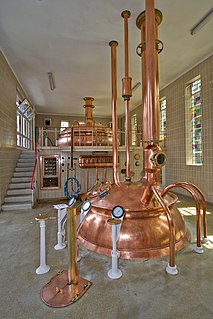 W
WA brewery or brewing company is a business that makes and sells beer. The place at which beer is commercially made is either called a brewery or a beerhouse, where distinct sets of brewing equipment are called plant. The commercial brewing of beer has taken place since at least 2500 BC; in ancient Mesopotamia, brewers derived social sanction and divine protection from the goddess Ninkasi. Brewing was initially a cottage industry, with production taking place at home; by the ninth century monasteries and farms would produce beer on a larger scale, selling the excess; and by the eleventh and twelfth centuries larger, dedicated breweries with eight to ten workers were being built.
 W
WA hogshead is a large cask of liquid. More specifically, it refers to a specified volume, measured in either imperial or US customary measures, primarily applied to alcoholic beverages, such as wine, ale, or cider.
 W
WBrewing is the production of beer by steeping a starch source in water and fermenting the resulting sweet liquid with yeast. It may be done in a brewery by a commercial brewer, at home by a homebrewer, or by a variety of traditional methods such as communally by the indigenous peoples in Brazil when making cauim. Brewing has taken place since around the 6th millennium BC, and archaeological evidence suggests that emerging civilizations, including ancient Egypt and Mesopotamia, brewed beer. Since the nineteenth century the brewing industry has been part of most western economies.
 W
WBrewing is the production of beer by steeping a starch source in water and fermenting the resulting sweet liquid with yeast. It may be done in a brewery by a commercial brewer, at home by a homebrewer, or by a variety of traditional methods such as communally by the indigenous peoples in Brazil when making cauim. Brewing has taken place since around the 6th millennium BC, and archaeological evidence suggests that emerging civilizations, including ancient Egypt and Mesopotamia, brewed beer. Since the nineteenth century the brewing industry has been part of most western economies.
 W
WA keg is a small barrel. Traditionally, a wooden keg is made by a cooper and used to transport items such as nails, gunpowder, and a variety of liquids.
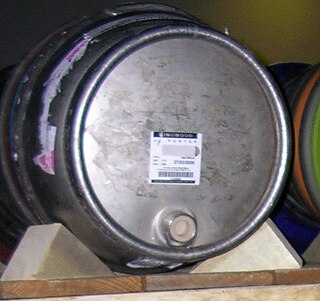 W
WA keystone is a small wooden or plastic fitting used in ale casks. For some years wooden casks have been effectively obsolete, with the majority now being aluminium or stainless steel, and a few sturdy plastic ones beginning to appear. Nevertheless, the standard tap is still designed to be hammered into yielding material, punching a hole as it goes. All modern casks, even the few wooden ones still in use, use a replaceable keystone to accept the tap.
 W
WKveik is a collective term for a family of strains of brewing yeast that has been used in Norwegian farmhouse brewing for generations.
 W
WLautering, a process in brewing beer, involves brewers separating the mash into the clear liquid wort and the residual grain. Lautering usually consists of three steps: mashout, recirculation, and sparging.
 W
WMalting is a process of steeping, germinating and drying grain to convert it into malt. The malt is mainly used for brewing or whisky making, but can also be used to make malt vinegar or malt extract. Various grains are used for malting; the most common are barley, sorghum, wheat and rye.
 W
WA mash rake or mashing rake is a tool used in the mashing process of brewing and distilling. The mash rake churns the mash to ensure it is mixed properly and is wet everywhere, so no sugars are wasted.
 W
WIn brewing and distilling, mashing is the process of combining a mix of grains – typically malted barley with supplementary grains such as corn, sorghum, rye, or wheat – known as the "grain bill" with water and then heating the mixture. Mashing allows the enzymes in the malt to break down the starch in the grain into sugars, typically maltose to create a malty liquid called wort.
 W
WA craft brewery or microbrewery is a brewery that produces small amounts of beer, typically less than large breweries, and is often independently owned. Such breweries are generally perceived and marketed as having an emphasis on enthusiasm, new flavors, and varied brewing techniques.
 W
WThe Oregon Hops and Brewing Archives (OHBA), established in 2013, is a community archive in the U.S. dedicated to collecting, preserving, and sharing materials about the story of Northwest hops and brewing.
 W
WThe Pink Boots Society (PBS) is a non-profit organization with international membership which supports women working in the brewing profession, especially in creating craft beer. The organization helps women brewers meet mentors, have the opportunity to network with other women in the profession and raises awareness of women in brewing. PBS also encourages women brewers to further their education and helps teach the skills needed to become beer judges. PBS raises money for scholarships for women to continue their education in brewing. There are around 1,800 members across the world. All members must be women and have some type of career in the brewing world or related to beer and beer-making.
 W
WRacking, often referred to as Soutirage or Soutirage traditionnel, also filtering or fining, is the process of moving wine or beer from one container to another using gravity rather than a pump, which can be disruptive to the beverage. The process is also known as Abstich in German and travaso in Italian.
 W
WThe Research Institute of Brewing and Malting (RIBM) in Czech - was founded in 1887 and since 1994 It has been a joint-stock company. It is one of the oldest scientific research institutes in the Central European region.
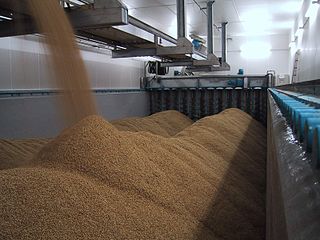 W
WA Saladin box is an instrument used for malting barley. It consists of a large rectangular container about 50 meters in length, and a set of vertical screws attached to a crossbar. The crossbar moves horizontally across the length of the container while the motion of the screws raise the barley from the bottom to the top. Combined with mechanical air flow across the barley for cooling, this allows for beds of barley between 60 cm (24 in) and 80 cm (31 in) deep to be turned over two or three times a day. The screws are moved and turned by a system of pulleys and belts.
 W
WA shive is a wooden or plastic fitting used in ale casks. It is found on the curved side of the cask, arranged so that when the cask is on its side and the keystone is at the lowest part of the rim, the shive will be the highest point of the cask.
 W
WGravity, in the context of fermenting alcoholic beverages, refers to the specific gravity, or relative density compared to water, of the wort or must at various stages in the fermentation. The concept is used in the brewing and wine-making industries. Specific gravity is measured by a hydrometer, refractometer, pycnometer or oscillating U-tube electronic meter.
 W
WA stuck fermentation occurs in brewing beer or winemaking when the yeast become dormant before the fermentation has completed. Unlike an "arrested fermentation" where the winemaker intentionally stops fermentation, a stuck fermentation is an unintentional and unwanted occurrence that can lead to the wine being spoiled by bacteria and oxidation. There are several potential causes of a stuck fermentation; the most common are excessively high temperatures killing off the yeast, or a must deficient in the nitrogen food source needed for the yeast to thrive. Once the fermentation is stuck, it is very difficult to restart due to a chemical compound released by dying yeast cells that inhibit the future growth of yeast cells in the batch. Winemakers often take several steps to limit the possibility of a stuck fermentation occurring, such as adding nitrogen to the must in the form of diammonium phosphate or using cultured yeast with a high temperature and alcohol tolerance. These steps will each have their own subtle or dramatic effect on the resulting flavors and quality of the wine.
 W
WSummat's Brewin', the fourth album by the Yorkshire-based folk music duo O'Hooley & Tidow, was released in August 2015 in a limited edition of 1,000 signed copies. The songs on the album explore society’s fascination with drink, drinking and real ale.
 W
WA tower brewery is a distinct form of brewery, identified by its external buildings being arranged in the form of a vertical tower.
 W
WIn the process of brewing beer, trub is the term used for the material, along with hop debris, left in the whirlpool or hopback after the wort has been boiled then transferred and cooled. Brewers generally prefer that the bulk of the trub be left in the whirlpool rather than stay in contact with the fermenting wort. Although it contains yeast nutrients, its presence can impart off-flavors in the finished beer.
 W
WVLB Berlin is the owner of the Institut für Gärungsgewerbe und Biotechnologie zu Berlin. It is an institute in Berlin's Wedding district that provides research, training, education and service for the brewing industry.
 W
WWomen have been active in brewing since ancient times. Though Western societies have viewed brewing as a male-dominated field for the last 150 years, traditionally, it was an activity engaged in by women. Ethnographic and archaeological studies have shown that brewing was an outcropping of gathering or baking traditions, which were predominantly women's roles throughout the world. From the earliest evidence of brewing in 7000 BCE, until the commercialization of brewing during industrialization, women were the primary brewers on all inhabited continents. In many cultures, the deities, goddesses and protectors of brewers were female entities who were associated with fertility.
 W
WBrewing is the production of beer by steeping a starch source in water and fermenting the resulting sweet liquid with yeast. It may be done in a brewery by a commercial brewer, at home by a homebrewer, or by a variety of traditional methods such as communally by the indigenous peoples in Brazil when making cauim. Brewing has taken place since around the 6th millennium BC, and archaeological evidence suggests that emerging civilizations, including ancient Egypt and Mesopotamia, brewed beer. Since the nineteenth century the brewing industry has been part of most western economies.
 W
WZymology, also known as zymurgy is an applied science which studies the biochemical process of fermentation and its practical uses. Common topics include the selection of fermenting yeast and bacteria species and their use in brewing, wine making, fermenting milk, and the making of other fermented foods.